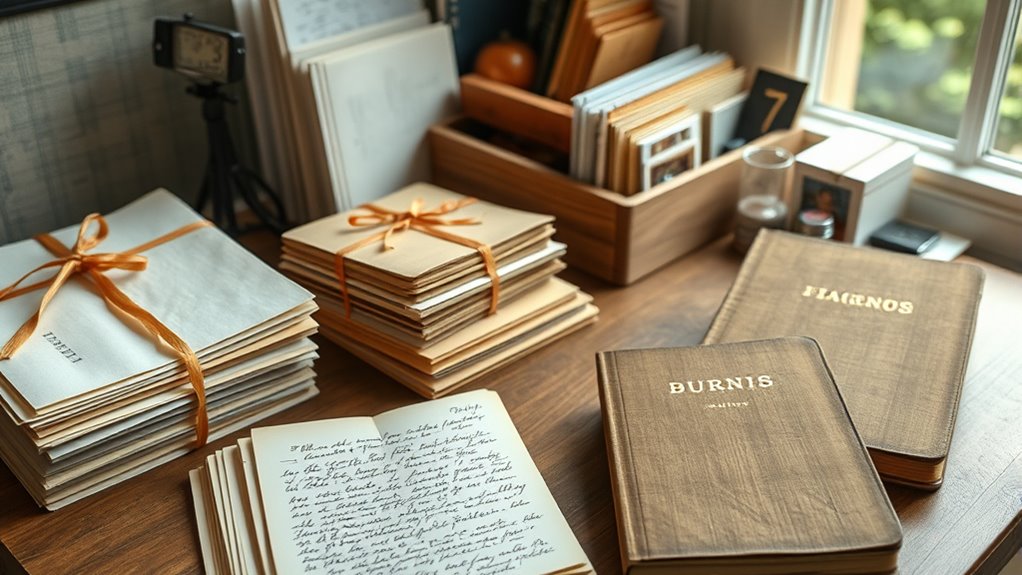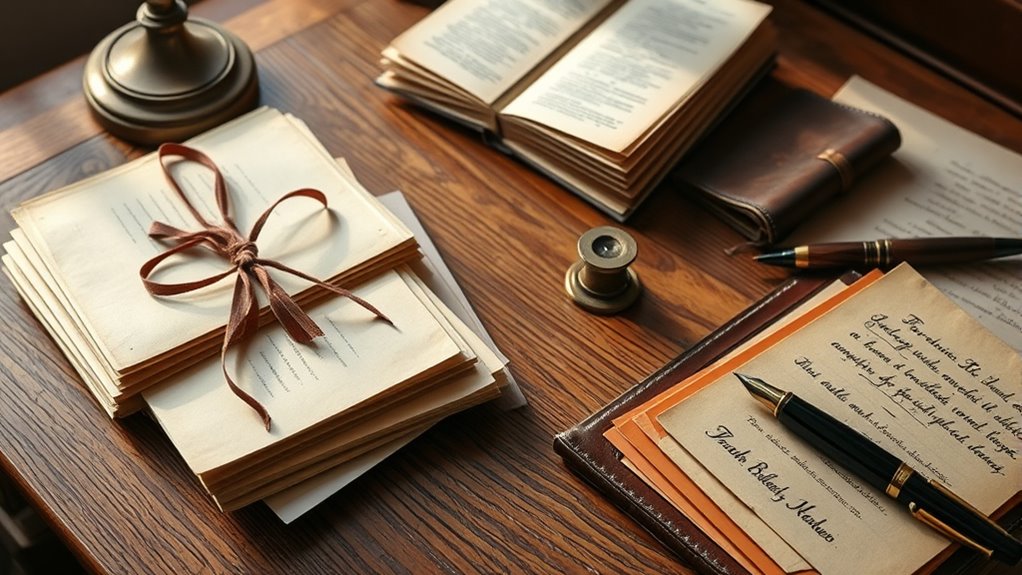To organize your letters, diaries, and personal papers, gather all items and sort them into categories like correspondence, journals, and photos. Decide which items to keep physically or digitize, scanning handwritten diaries and important letters for easy access. Store physical documents securely in labeled folders or containers, and back up digital copies regularly. Maintaining an inventory and routine checks will keep your collection manageable and protected—continue exploring ways to preserve your memories effectively.
Key Takeaways
- Gather all personal papers and categorize them into groups like letters, diaries, and official documents.
- Decide which items to keep physically and which to digitize for easier access and preservation.
- Scan handwritten diaries and treasured letters using high-resolution settings, maintaining consistent naming conventions.
- Store physical papers securely in fireproof, waterproof containers, and protect digital files with encryption and strong passwords.
- Regularly review, update, and back up digital files, and maintain an inventory to organize and locate documents efficiently.

Organizing your personal papers can seem overwhelming, but taking systematic steps makes the task manageable. When it comes to letters, diaries, and personal documents, a good starting point is to consider digital archiving. Digital archiving allows you to scan important papers and store them securely on your computer or cloud services, freeing up physical space and making your collection easier to search through. As you digitize these items, be sure to prioritize privacy protection. Use strong, unique passwords for your storage accounts, and consider encryption options to keep sensitive information safe from unauthorized access. This way, you can enjoy the convenience of digital access without sacrificing your privacy.
Digital archiving of personal papers enhances security, saves space, and simplifies access with strong passwords and encryption.
Begin by gathering all your personal papers in one place. Sort through them carefully, creating categories such as correspondence, journals, photographs, and official documents. As you sort, decide which items are worth keeping in physical form and which can be safely stored digitally. You might choose to scan handwritten diaries or treasured letters, converting them into digital files that are easy to back up and preserve. When scanning, opt for high-resolution images to retain detail, and organize the digital files with clear, consistent naming conventions. This process not only streamlines your collection but also helps you locate specific items quickly in the future.
While digitizing, always be mindful of privacy protection. Avoid storing sensitive data on insecure or shared networks, and regularly update your passwords. For added security, consider using password-protected folders or encrypted drives. For physical documents, store them in a safe, dry place, preferably in a fireproof and waterproof container. Keep in mind that some personal papers, like legal documents or delicate letters, may require extra care. For these, you might want to keep the originals in a secure location and only digitize copies for everyday reference. Additionally, understanding the History of Pinball Machines can inspire you to create a themed organization system that reflects your personal interests.
As you organize, create an inventory list of your papers, both physical and digital. This list helps you maintain control over your collection, know what you have, and avoid duplicates. Additionally, establish a routine for ongoing organization, such as quarterly reviews or annual backups, to ensure your collection remains manageable and protected over time. By combining digital archiving with vigilant privacy protection, you not only preserve your personal history but also control who can access it, giving you peace of mind. With deliberate planning and consistent effort, organizing your letters, diaries, and personal papers becomes an empowering way to safeguard your memories and important documents for years to come.
Frequently Asked Questions
How Should I Prioritize Which Items to Keep?
You should start by evaluating the sentimental value of each item to prioritize what’s most meaningful to you. Use prioritization strategies like sorting items into categories—keep, donate, or discard—based on emotional significance and historical importance. Focus on preserving letters or diaries that reveal personal stories or milestones. This approach helps you efficiently organize your collection while ensuring you retain what truly matters, making your keepsakes manageable and meaningful.
What Are the Best Methods for Protecting Fragile Papers?
Did you know that over 75% of paper deterioration is caused by acids? To protect fragile papers, you should use acid-free storage materials and keep them in climate-controlled environments. Maintain a stable temperature between 65-70°F and humidity around 40-50%. These precautions help prevent further degradation and preserve your documents’ integrity, ensuring they stay intact for generations.
How Can I Digitize Old Handwritten Letters Effectively?
To digitize your old handwritten letters effectively, start with a high-quality scanner to guarantee clear images. Use digital archiving techniques to organize and store the scanned files securely. Consider applying optical character recognition (OCR) to convert handwritten text into editable digital content, making your letters more accessible. Regularly back up your digital archive to prevent data loss. This approach helps preserve your memories and makes sharing easier.
What Should I Do With Sensitive or Private Documents?
You should handle sensitive or private documents with confidential handling and secure storage. First, digitize them carefully, using password-protected files or encrypted storage. Keep the originals in a safe, locked location, like a fireproof safe or secure cabinet. Limit access to trusted individuals and consider shredding duplicates if no longer needed. This way, your private information stays protected while still being accessible when necessary.
How Often Should I Review and Reorganize My Collection?
Like updating your smartphone, you should review and reorganize your collection periodically—at least once a year or when life changes. This helps with time management and archival planning, ensuring your papers stay accessible and protected. Regular checks prevent deterioration and make it easier to find important documents. Treat your collection like a vintage game console; upkeep keeps everything functioning smoothly and preserves its value for future generations.
Conclusion
As you organize your letters, diaries, and personal papers, you realize how each piece connects to your life’s story—almost like they were waiting for you to find them. The more you arrange, the clearer the picture becomes, revealing moments you thought were lost. Sometimes, it’s funny how a simple box of papers can unexpectedly lead you to a deeper understanding of yourself. In this way, your past quietly guides your present, shaping who you are today.








